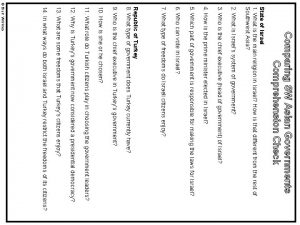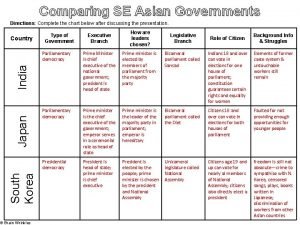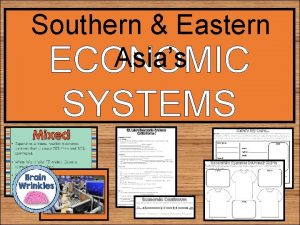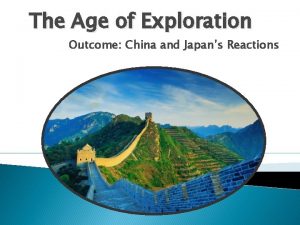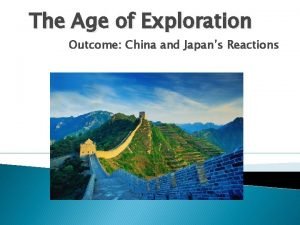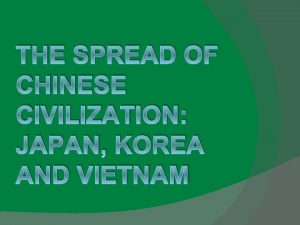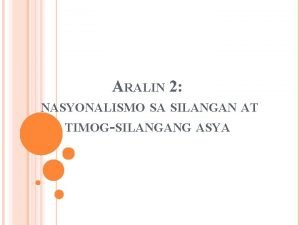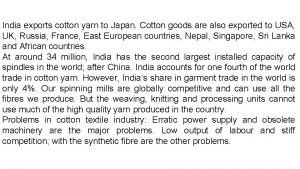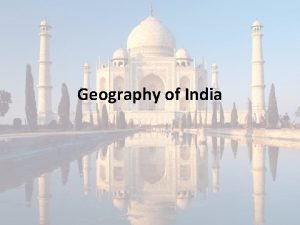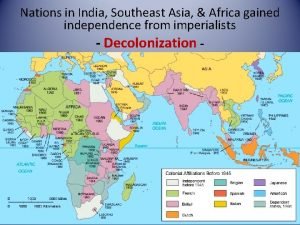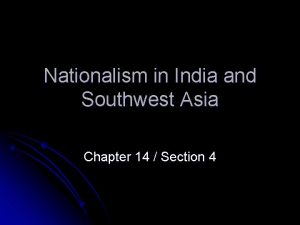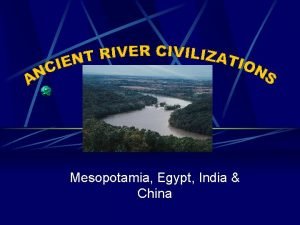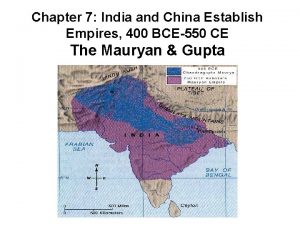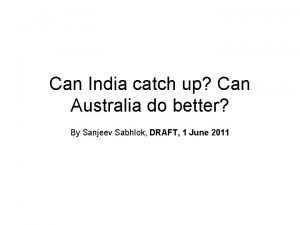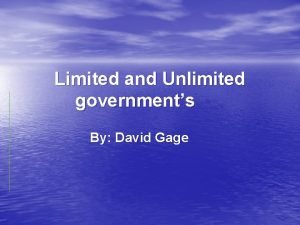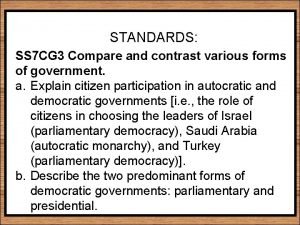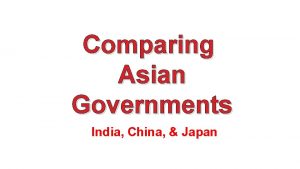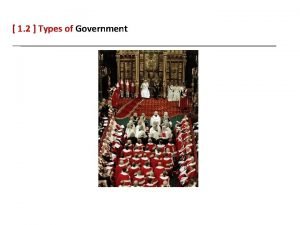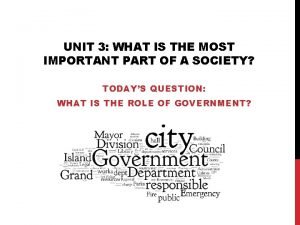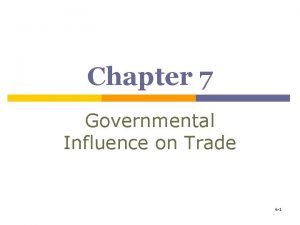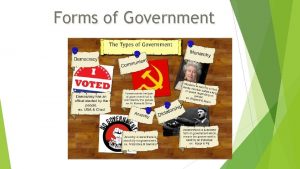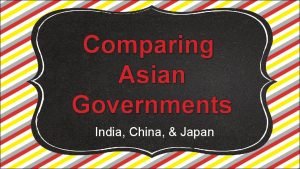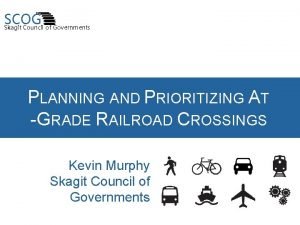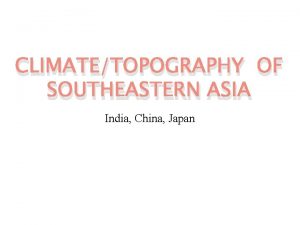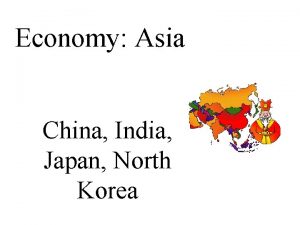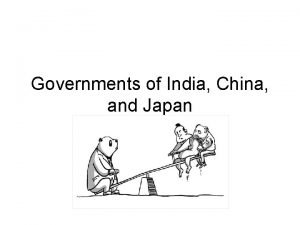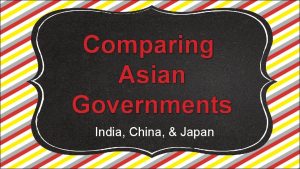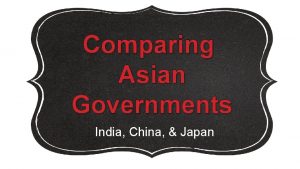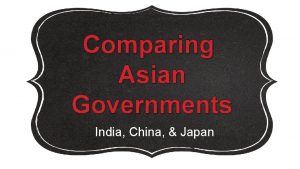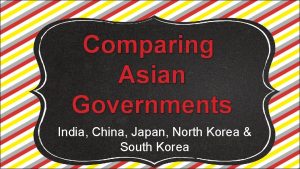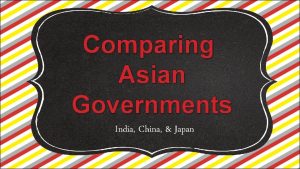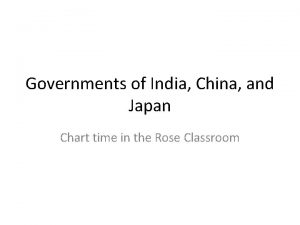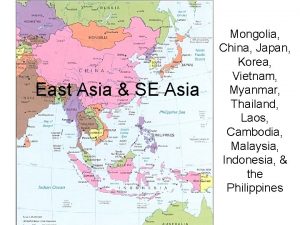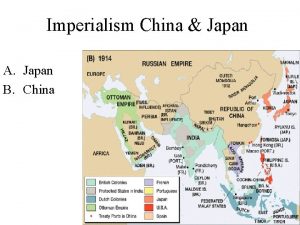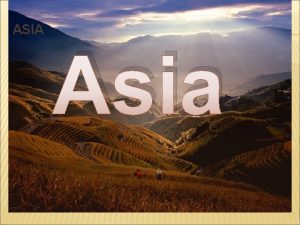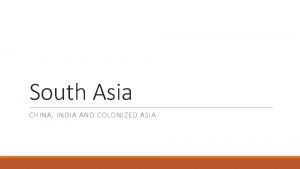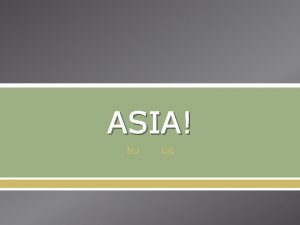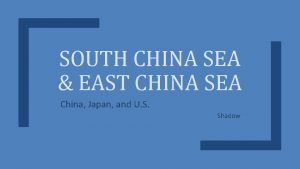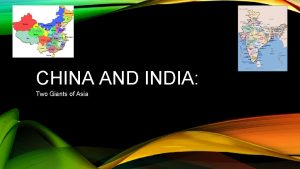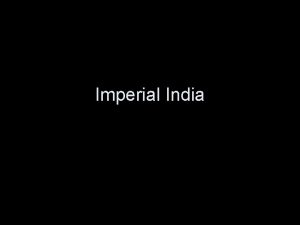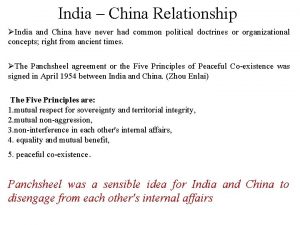Governments in Asia India Japan China SS 7






























- Slides: 30

Governments in Asia India Japan China SS 7 CG 7 The student will demonstrate an understanding of national governments in Southern and Eastern Asia. a. Compare and contrast the federal republic of The Republic of India, the communist state of The People’s Republic China, and the constitutional monarchy of Japan, distinguishing the form of leadership and the role of the citizen in terms of voting rights and personal freedoms.

Terms to know… Chief of state includes the name and title of the leader of the country who represents the state at official and ceremonial functions, but who may not be involved with the day-to-day activities of the government. Head of government includes the name and title of the top administrative leader who is designated to manage the day-to-day activities of the government. For example, in Japan, the emperor is the chief of state, and the prime minister is the head of government. {In the US, the president is both the chief of state and the head of government. } Republic- a state in which supreme power is held by the people and their elected representatives, and which has an elected or nominated president rather than a monarch. Remember, just because a country calls itself a republic, doesn’t necessarily mean that it is.

The Republic of India. A Federal Republic- Democracy

Federal Republic of India established its own constitution, separate from Great Britain in 1950 • India is considered a Federal Republic. It is the largest democracy in the world (based on population) Head of Government: India has a President and a Prime Minister. The President is the head of state while the Prime Minister is the head of government. •

Pranab Kumar Mukherjee is the 13 th and current President of India, in office since July 2012. *The President is elected by the elected members of the Parliament of India as well as of the state legislatures and serves for a term of five years. *A president appoints the prime minister. The president actually has no real power and can only appoint the senior member of the majority party of legislature.

Narenda Modi In office since May 2014 The head of government of the Republic of India, and head of the Council of Ministers, appointed by the President. The Prime Minister is responsible for bringing proposal of legislation. Recognized as leader of the majority party in the two Houses of the Parliament of India.

Citizens Rights and Freedoms • All citizens 18 and over may vote for their legislators. • India’s citizens are guaranteed the right to vote, freedom of speech, freedom of assembly, and freedom of religion. • Indians also have the right to conserve their native language and culture and establish schools to teach about their culture.

The People’s Republic of China. A Communist State

The People’s Republic of China Although China is called a republic, true power lies with the ruling Communist Party. This began in 1949. China has a President and a Premier. Head of Government: The President is the head of state while the Premier is the head of government. The President and Vice-President are elected by the National People’s Congress. Communism- A communist state is a state where the means of production are collectively owned by the society. It has a form of government characterized by single-party rule or dominant-party rule of a communist party. A society in which all property is publicly owned and each person works and is paid according to their abilities and needs.

Xi Jinpin –President since 2013 Xi Jinping is the : • General Secretary of the Communist Party of China • The President of the People's Republic of China • The Chairman of the Central Military Commission. • The highest position in government is the president, whose duties are mostly ceremonial.

Li Keqiang- Premier of the State Council of the People's Republic of China Since March 2013 The head of the government is the Premier who leads the State Council, or Cabinet, which holds executive power in China.

China cont… • Even though leaders are officially chosen by China’s legislature, the Chinese Communist Party chooses and recommends the candidates. • Citizens rights and participation: • Every citizen over 18 is allowed to vote. However, they may only vote for candidates chosen by the CCP. • Citizen’s rights are mostly meaningless as there is no constitution. Citizens have been denied basic rights at times in the past.

One Child Policy This policy was introduced in 1979 to alleviate social, economic, and environmental problems in China. The policy allows many exceptions such as: rural families can have a second child if the first child is a girl or is disabled, or if both parents do not have siblings. In November 2013, the Chinese government announced that it would further relax the policy by allowing families to have two children if one of the parents is an only child.

Japan’s Government. Constitutional Monarchy

The Constitutional Monarchy of Japan -began in 1947 The Emperor of Japan (head of state) is merely a “symbol of the state. ” True executive power resides with the Prime Minister (head of government), and the Cabinet of Ministers, who are part of the legislative branch of government. There are universal voting rights for all adult citizens 20 years and older. Emperor Akihitio, Empress Michiko and other members of the imperial family at a New Year's Day ceremony at the Imperial Palace

Emperor Akihito He is the head of the Japanese Imperial Family. The highest authority of the Shinto religion. Head of government: There is an Emperor and Prime Minister Under Japan's present constitution, the Emperor is the "symbol of the state and the unity of the people, " and is a ceremonial figurehead in a constitutional monarchy Born in 1933

The Prime Minister is appointed by the Emperor of Japan. Must have the confidence of the House of Representatives to remain in office. Shinzō Abe is a Japanese politician and the current Prime Minister of Japan since December 2012. He previously served as Prime Minister from 2006 to 2007 Shinzo Abe

Rights and Freedoms • Japan’s legislature is called the “Diet”. It consists of two houses • Members of the Diet are elected by Japan’s citizens. All citizens may vote once they reach age 20. • Japan’s citizens are guaranteed the rights of freedom of speech, equal rights for women, equal education. • Japan’s constitution makes it illegal for the country to use war as a method of solving problems.

COUNTRY TYPE OF GOV’T How do they become leaders in this country? Form of Leadership Personal Freedoms? India Federal Democracy President – Electoral College Prime Minister – Head of Majority legislative branch President – head of state Prime Minister – head of gov’t 18 and older vote China Republic (fake) President – chosen by National People’s Congress Premier (Prime Minister) – Head of the Ruling Party (Communist Party) President – head of state Premier (Prime Minister) – head of government None Emperor – Inherited Prime Minister – chosen by the Diet and emperor gives blessing Emperor – head of state Prime Minister – head of government 20 and older vote Lead by Communist Party Japan Constitutional Monarchy

*The prime minister is the head of government The government’s true power lies with the Prime Minister and the Cabinet Based on the information above, which term identifies Japan’s government? A. federal republic B. communist state C. constitutional monarchy D. autocratic confederation

The emperor holds a ceremonial role as head of state The prime minister is the head of government The government’s true power lies with the Prime Minister and the Cabinet Based on the information above, which term identifies Japan’s government? A. federal republic B. communist state C. constitutional monarchy * D. autocratic confederation

A national government as well as 28 state governments The leader of each state legislature's majority is appointed governor by the president Citizens of each state elect state legislatures Based on the information above, which term identifies India's government? A. federal republic B. communist state C. constitutional monarchy D. autocratic confederation

a national government as well as 28 state governments the leader of each state legislature's majority is appointed governor by the president citizens of each state elect state legislatures Based on the information above, which term identifies India's government? A. federal republic * B. communist state C. constitutional monarchy D. autocratic confederation

How Governments Determine Citizen Participation Low or No Participation Autocratic Low or No Participation Oligarchic Citizen Participation Government Power General Citizens’ Participation Select Citizens’ Participation High Participation Government Power Citizen Participation Government Power High Participation Low or No Participation Democracy

In Japan, the prefectures (Japan’s word for states or provinces) do not have any independent authority. Instead, they carry out the laws and policies of the national government. This is an example of what system of government? A. Unitary B. Confederation C. Federal D. parliamentary

In Japan, the prefectures (Japan’s word for states or provinces) do not have any independent authority. Instead, they carry out the laws and policies of the national government. This is an example of what system of government? A. Unitary* B. Confederation C. Federal D. parliamentary

How does a democratic government differ from an oligarchic government? A. Role of the citizen B. Law making process C. Judicial system D. Role of individual states

How does a democratic government differ from an oligarchic government? A. Role of the citizen* B. Law making process C. Judicial system D. Role of individual states

In a parliamentary government, unlike the presidential system, the head of government belongs to which branch? A. Judicial B. National C. Executive D. Legislative

In a parliamentary government, unlike the presidential system, the head of government belongs to which branch? A. Judicial B. National C. Executive D. Legislative*
 Governments comprehension check
Governments comprehension check Comparing sw asian governments
Comparing sw asian governments Comparing sw asian governments
Comparing sw asian governments Sw asian economies comprehension check
Sw asian economies comprehension check The age of exploration outcome china and japan's reactions
The age of exploration outcome china and japan's reactions Japan during the age of exploration
Japan during the age of exploration Spread of china's literature to heian japan and korea
Spread of china's literature to heian japan and korea Bahaging ginampanan ni sun yat sen
Bahaging ginampanan ni sun yat sen India export yarn to japan
India export yarn to japan Where is india located in asia
Where is india located in asia Nationalism in india and southwest asia
Nationalism in india and southwest asia Is india southeast asia
Is india southeast asia Nationalism in india and southwest asia
Nationalism in india and southwest asia Nationalism in india and southwest asia
Nationalism in india and southwest asia Ancient india vs ancient china
Ancient india vs ancient china Map of mesopotamia egypt india and china
Map of mesopotamia egypt india and china Casa sumeria
Casa sumeria Chapter 7 india and china establish empires
Chapter 7 india and china establish empires India china
India china Comparative development experiences of india and china
Comparative development experiences of india and china Is a anarchy limited or unlimited
Is a anarchy limited or unlimited Comparing sw asian governments
Comparing sw asian governments Is japan a unitary state
Is japan a unitary state What are the three ways to classify governments
What are the three ways to classify governments Comparing african governments
Comparing african governments Are city governments tax exempt
Are city governments tax exempt Different kind of governments
Different kind of governments Essential industry argument
Essential industry argument How are governments classified
How are governments classified Comparing asian governments
Comparing asian governments Skagit council of governments
Skagit council of governments
